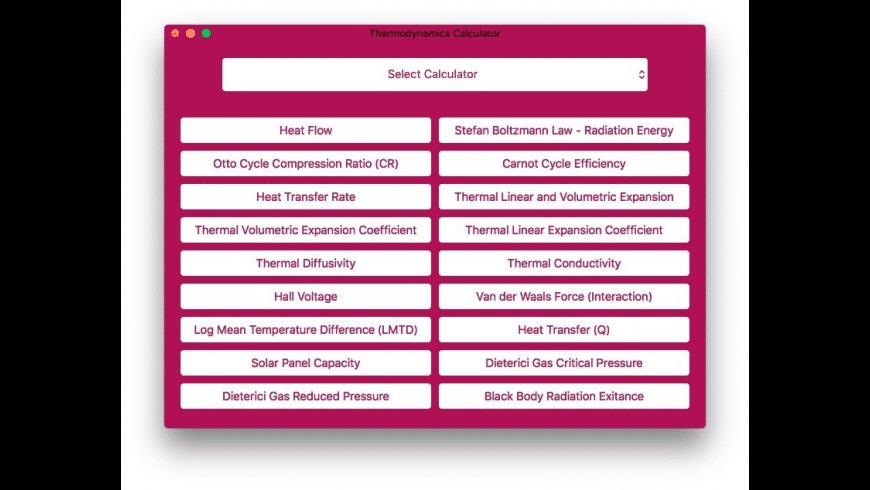Thermodynamics calculators give you a list of online Thermodynamics calculators. A tool perform calculations on the concepts and applications for Thermodynamics calculations. These calculators will be useful for everyone and save time with the complex procedure involved to obtain the calculation. Try all the online heat and work calculators and simplify your thermodynamics related calculations in the most convenient way. Thermodynamics: It is the branch of physics which deals with the relationship between heat, work, temperature, and energy. Calculate online thermodynamic and transport properties of water and steam, based on industrial (IAPWS-IF97) or scientific (IAPWS-95) formulation. Mollier diagrams included.
Let's start with couple of definitions: Heat is the amount of energy flowing from one body of matter to another spontaneously due to their temperature difference, or by any means other than through work or the transfer of matter. Historically, many energy units for measurement of heat have been used. The standards-based unit in the International System of Units (SI) is the joule (J).

1.1. Choice of state variables
For a pure fluid (fluid consisting of a single chemical species) two variables are necessary tocompletely describe its thermodynamic state. In theory, these could be any two from the followinglist:

- pressure
- temperature
- density
- specific enthalpy
- specific entropy
In reality, there are good choices and bad choices of state variables. A choice could be alsogood or bad depending on the particular state of the fluid. For an incompressible fluid, forexample, choosing the density as a state variable is apparently not suitable. Pressure andtemperature are always a good choice, except when properties are calculated in the two-phase region(boiling/condensation). Temperature and density are always a good choice for compressible fluids.Temperature and enthalpy are an unsuitable combination as they are strongly correlated, while pressureand enthalpy are a very good combination. How suitable the selected combination of state variables isdepends also on the particular equations of state used.
1.2. Two-phase region
If a liquid is heated beyond its boiling point at a pressure below its critical pressure, the fluidstarts evaporating. During evaporation the temperature and pressure are linked to each other, andif, for example, the pressure is kept constant, so remains the temperature. This part of the fluid statediagram is called the two-phase region, because a partially evaporated fluid contains a liquid phase and avapor phase. The mass fraction of the vapor phase is called vapor quality q. Thus (q = 0) indicatesan all-liquid (saturated liquid) state, and (q = 1) indicates a saturaded vapor state. The property of theoverall fluid in the two-phase region depends on the property of both phases and the q, e.g.


where subscript v indicates vapor properties and subscript l - liquid ones.
In order to obtain the boiling temperature at a given pressure, the user enters the pressure and an arbitraryvalue in the range 0-1 for q.
All the fluid properties on this page are calculated using the open-source propertypackage CoolProp. CoolProp is an open-source,cross-platform, free property database based on C++ that includes pure fluids,pseudo-pure fluids, and humid air properties. A complete list of all the materialsimplemented in CoolProp can be found here
Caution: When using pseudo-pure fluids (like Air), there is a chance you may obtain funny valuesfor properties under ceratain conditions (e.g. at a low temperature). Thus, better use pure fluids(e.g. Nitrogen) whenever possible.
3.1. P-H diagram
3.1.1. Isentrops
A special algorithm was developed for tracing isentrops, so that most calculations can be expressed in termsof the fundamental variables of the equation of state: temperature and density.
- Start from a seed poing (f_0)
- Compute the fluid state based on (s) and (T) variables
- Find (left(frac{partialrho}{partial T}right)_{s}).
- Select a step (Delta T) and find (Delta rho) from
- Compute the fluid state at (f_1) by (T_0 + Delta T) and (rho_0 + Deltarho)
- Go back to 3. using (f_1)
We use Maxwell relations to find the derivative:
Which can be expressed as:
Using the total derivative of (s):
Thermodynamics Calculators
And taking the partial derivative:
Finally:
In the single phase region the two partial derivatives on the right can be calculated directly. In the two-phase region, we can use:
And therefore the total (s) derivative can be expressed as:
Taking the partial derivative:
First Law Of Thermodynamics Calculator
The terms can be expressed as follows:

The right-hand side of the second equation contains two terms, which can be expressed as follows:
Thermodynamics Calculator Physics
Therefore we have:
3.1.2. Isochores
Determine the appropriate ranges for (T) and (rho) andcompute the fluid state based on those variables
W= Work Done; R =Universal Gas Constant ; T = Temperature ; V1 , V2=Initial and Final Volume ,
n = number of Moles;
η = Efficiency ; Thot =Temperature of the Hot source ; Tcold = Temperature of the Cold Sink ;
ΔS = Entropy Change ; R = Universal Gas Constant ; V1 = Initial Volume ; V2 = Final Volume;
P1 & P2 = Initial & Final Pressure ; ΔvapHm = Molar Enthalpy of vaporization ; T1 , T2 =Initial & Final Temperature ; R= Gas Constant ;
ΔH= Enthalpy Change ; Cp = Heat Capacity at constant Pressure; T1 , T2 = Initial & Final Temperature ;
ΔH= Enthalpy change ; ΔU = Internal Energy Change ; n1 , n2 = Gaseous reactant's and Product's Total Mole Number;
ΔU= Internal Energy Change ; Cv = Heat Capacity at constant Volume ; T2 , T1 = Final and Initial Temperature;
S=Entropy ; KB = Bolzmann's Constant ; W = Number of microsates
F= Number of Variables ; C= Number of Components ; P= Number of Phases;
Q= Amount of Heat ; m= mass ; s = Specific Heat ; θ = Temperature Change (a.k.a ΔT)
Pages
